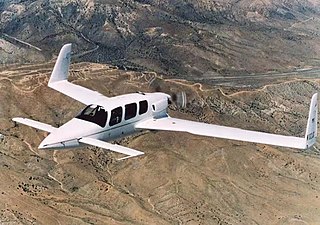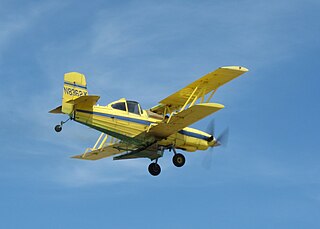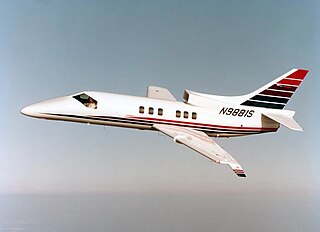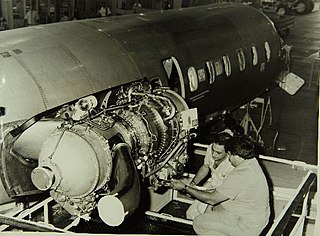
A turboprop is a gas turbine engine that drives an aircraft propeller.

A business jet, private jet, or bizjet is a jet aircraft designed for transporting small groups of people, typically business executives and high-ranking associates. Business jets are generally designed for faster air travel and more personal comfort than commercial aircraft, and may be adapted for other roles, such as casualty evacuation or express parcel deliveries, and some are used by public bodies, government officials, VIPs, or even the military.

The Raytheon T-1 Jayhawk is a twin-engined jet aircraft used by the United States Air Force for advanced pilot training. T-1A students go on to fly airlift and tanker aircraft. The T-400 is a similar version for the Japan Air Self-Defense Force.

The bypass ratio (BPR) of a turbofan engine is the ratio between the mass flow rate of the bypass stream to the mass flow rate entering the core. A 10:1 bypass ratio, for example, means that 10 kg of air passes through the bypass duct for every 1 kg of air passing through the core.
Gulfstream Aerospace Corporation is an American aircraft company and a subsidiary of General Dynamics. Gulfstream designs, develops, manufactures, markets, and services business jet aircraft. Gulfstream has produced more than 2,000 aircraft since 1958. Gulfstream's current range consists of the G280, G400, G500/G600, and G650/G650ER/G700/G800.

A propfan, also called an open rotor engine, open fan engine or unducted fan, is a type of aircraft engine related in concept to both the turboprop and turbofan, but distinct from both. The design is intended to offer the speed and performance of a turbofan, with the fuel economy of a turboprop. A propfan is typically designed with a large number of short, highly twisted blades, similar to the (ducted) fan in a turbofan engine. For this reason, the propfan has been variously described as an "unducted fan" (UDF) or an "ultra-high-bypass (UHB) turbofan".

The AASI Jetcruzer was an American single turboprop light civil transport made by Advanced Aerodynamics and Structures Inc. The Jetcruzer had an unusual configuration, with a single turboprop engine driving a pusher propeller, a prominent canard, and fins mounted at the ends of its swept wings. The plane has seating for up to six people including the pilot. The Jetcruzer is noteworthy for being the first aircraft to have achieved a spin resistance certification from the United States FAA.
The Interceptor 400 was a turboprop-powered single-engined light aircraft developed from the Meyers 200 single-engine piston plane. It attracted buyers but was unable to obtain adequate manufacturing financing, and was perhaps too far ahead of its time. In the late 1960s and early 1970s, at the time of its development, the market for single-engined turboprops was still a decade away.

The Ayres Thrush, formerly the Snow S-2, Aero Commander Ag Commander, and Rockwell Thrush Commander, is an American agricultural aircraft produced by Ayres Corporation and more recently by Thrush Aircraft. It is one of the most successful and long-lived agricultural application aircraft types in the world, with almost 2,000 sold since the first example flew 68 years ago. Typical of agricultural aircraft, it is a single-seat monoplane of conventional taildragger configuration. Originally powered by a radial piston engine, most examples produced since the 1980s have been turboprop-powered.

The Cessna 441 Conquest II is the first turboprop powered aircraft designed by Cessna and was meant to fill the gap between their jets and piston-engined aircraft. It was developed in November 1974, with the first aircraft delivered in September 1977. It is a pressurized, 8–9 passenger turbine development of the Cessna 404 Titan. The ICAO designator as used in flight plans is C441.

The Grumman G-164 Ag Cat is a single-engined biplane agricultural aircraft, developed by Grumman in the 1950s.

The Scaled Composites ARES is a demonstrator aircraft built by Scaled Composites. ARES is an acronym for Agile Responsive Effective Support.

The Pratt & Whitney Canada JT15D is a small turbofan engine built by Pratt & Whitney Canada. It was introduced in 1971 at 2,200 lbf (9,800 N) thrust, and has since undergone a series of upgrades to just over 3,000 lbf (13 kN) thrust in the latest versions. It is the primary powerplant for a wide variety of smaller jet aircraft, notably business jets.
Allen Eugene Paulson was an American businessman.

The Swearingen Merlin or the Fairchild Aerospace Merlin is a pressurized, twin turboprop business aircraft first produced by Swearingen Aircraft, and later by Fairchild at a plant in San Antonio, Texas.

The Gulfstream American Peregrine 600 was a military trainer aircraft developed in the United States in the early 1980s but which did not progress further than prototype stage.

The Gulfstream Aerospace Peregrine was a single-engine business jet prototype aircraft developed in the United States by Gulfstream Aerospace in the early 1980s. It was developed from the company's Hustler business aircraft and the company's military trainer aircraft, the Peregrine 600.

The Garrett TPF351 is a turboprop engine designed by Garrett Engine Division of AlliedSignal Aerospace Company. Initiated by Garrett in October 1987, the TPF351-20 engine was selected by Embraer to power the Embraer/FMA CBA 123 Vector, a high-speed commuter "pusher" aircraft. It was first tested on May 19, 1989 and then ground tested and flight tested on a Boeing 720 on July 9, 1990. The first prototype CBA 123 was tested on July 18, 1990, followed by a flight to the Farnborough Air Show in September of the same year. Both programs were cancelled in 1992, when the TPF351 was nine months from engine certification.

The Conroy Tri-Turbo-Three was a Douglas DC-3 fitted with three Pratt & Whitney Canada PT6A turboprop engines by Conroy Aircraft; the third engine was mounted on the nose of the aircraft.

The Weatherly 620 is a 1970s American agricultural monoplane designed and built as an improved variant of the Weatherly 201 by the Weatherly Aircraft Company of McClellan, California.

















